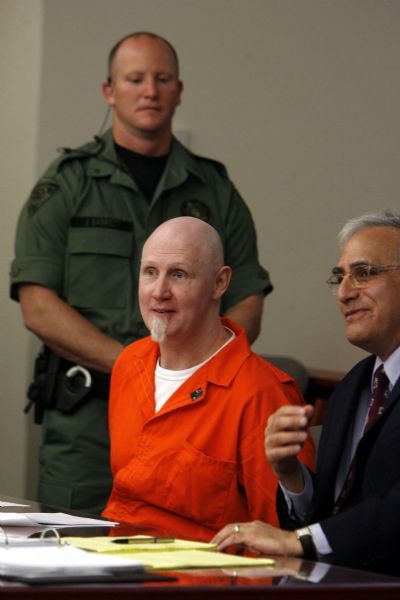This is an archived article that was published on sltrib.com in 2010, and information in the article may be outdated. It is provided only for personal research purposes and may not be reprinted.
Shackled at his ankles and wrists and wearing an orange jump suit, Ronnie Lee Gardner leaned forward in his
chair Friday and uttered seven words that will place Utah in the international spotlight.
"I would like the firing squad, please," Gardner said, his voice choking up.
Choosing bullets over lethal injection may have nothing to do with making headlines for Utah -- the first state to execute a killer after the U.S. Supreme Court reinstated the death penalty in 1976 and the only to allow inmates to die by firing squad.
Gardner's cousin, Jerry Hainsworth, said Gardner told him a few years ago: "I'd rather do it that way because I've been shot a bunch of times."
That includes a bullet wound suffered during Gardner's 1985 escape attempt from the since demolished Salt Lake County courthouse. Police shot Gardner in the neck while trying to apprehend him after he escaped from prison in 1981. Hainsworth said Gardner was shot in the leg with a .22-caliber rifle as a child, was once wounded in a shootout with a brother-in-law, and once accidently shot himself in the thigh.
After hearing Gardner's request, 3rd District Court Judge Robin Reese on Friday signed a death warrant setting his execution date for June 18. The judge rejected Gardner's latest appeal of his 1985 death sentence minutes earlier, leaving a Utah Supreme Court appeal or a commutation from the Utah Board of Pardons as Gardner's only chances to avoid death.
Already on Friday opponents of capital punishment were anticipating the intense scrutiny Gardner's death would generate for Utah.
"It's so unusual and harks back to a whole other era," said Richard Dieter, executive director of the Death Penalty Information Center in Washington, D.C. "This is a spectacle in a sense."
The last Utah inmate to die by firing squad was John Albert Taylor in 1996, who said he selected the method to embarrass the state. Satellite trucks filled a large parking lot near the state prison in Draper.
Jack Ford, who was then the Utah Department of Corrections spokesman, on Friday read a list of reporters, photographers and other media personnel who were on the prison grounds. Ford estimated there were 150 media personnel in all, including major American news outlets and journalists from Great Britain, Denmark, Italy and Australia.
International journalists detailed how the shots rang out, Ford said, reporting the story as if to say, "You can't believe what they do in the United States."
The current Corrections spokesman, Steve Gehrke, said as of Friday afternoon he had already received inquiries from several national media outlets. Visiting reporters will find the firing squad still has its proponents among Utah lawmakers. In 2004, when the Legislature was debating whether to eliminate the firing squad, then-Sen. David Thomas, R-South Weber, and others like him supported keeping the method.
"I know there are a lot who suggest getting rid of firing squad is more humane but we've had the firing squad since statehood and it's effective," Thomas told The Salt Lake Tribune Friday.
Prior to Taylor, the inmate to die by firing squad was Gary Gilmore, whose crimes and execution spawned the book The Executioner's Song and a television movie of the same name.
Gardner chose to die by firing squad after his conviction in 1985. But when death warrants were issued for Gardner in 1990 and 1996, he chose lethal injection. All those execution dates were stayed through appeals. Gardner, citing his arthritis and leukemia, also has wavered over whether he wants to keep appealing or submit to his sentence.
On Friday, 10 bailiffs and prison guards were ready in the courtroom as Gardner was led in through a side door at 9:14 a.m.
Gardner sat with his lawyers, then turned to greet Utah Attorney General Mark Shurtleff. Shurtleff reciprocated and asked Gardner how he was doing.
"Good considering the circumstances," Gardner said.
Gardner sat quietly through the two-hour hearing, occasionally pivoting his head from shoulder to shoulder.
His lawyers argued Friday that putting Gardner to death after 25 years of litigation amounted to unconstitutional cruel and unusual punishment and that his rights were violated because the state did not pay for experts to testify about his abusive childhood and alleged brain damage during the penalty phase of his 1985 trial.
Thomas Brunker, an assistant attorney general who represented the state in the hearing, said other courts have already heard and ruled against those arguments.
Gardner's attorneys also introduced evidence Friday that his victims' family and friends oppose the imposition of the death sentence. But Reese said Gardner had exhausted all his legal options.
"It's my conclusion not to second-guess the courts or undertake an independent review," the judge said.
Hainsworth, who did not attend Friday's hearing, said he feels his cousin wasn't surprised by the ruling.
"He knows what he did," Hainsworth said. "The last time I talked to him he told me straight up: 'There's no doubt in my mind I deserve what I'm getting.'"











